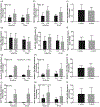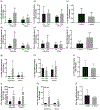The effect of autologous repair and voluntary wheel running on force recovery in a rat model of volumetric muscle loss
- PMID: 33600045
- PMCID: PMC8628541
- DOI: 10.1113/EP089207
The effect of autologous repair and voluntary wheel running on force recovery in a rat model of volumetric muscle loss
Abstract
New findings: What is the central question of this study? Following large traumatic loss of muscle tissue (volumetric muscle loss; VML), permanent functional and cosmetic deficits present themselves and regenerative therapies alone have not been able to generate a robust regenerative response: how does the addition of rehabilitative therapies affects the regenerative response? What is the main finding and its importance? Using exercise along with autologous muscle repair, we demonstrated accelerated muscle force recovery response post-VML. The accentuated force recovery 2 weeks post-VML would allow patients to return home sooner than allowed with current therapies.
Abstract: Skeletal muscle can regenerate from damage but is overwhelmed with extreme tissue loss, known as volumetric muscle loss (VML). Patients suffering from VML do not fully recover force output in the affected limb. Recent studies show that replacement tissue (i.e., autograph) into the VML defect site plus physical activity show promise for optimizing force recovery post-VML. The purpose of this study was to measure the effects of autologous repair and voluntary wheel running on force recovery post-VML. Thirty-two male Sprague-Dawley rats had 20% of their left tibialis anterior (LTA) excised then replaced and sutured into the intact muscle (autologous repair). The right tibialis anterior (RTA) acted as the contralateral control. Sixteen rats were given free access to a running wheel (Wheel) whereas the other 16 remained in a cage with the running wheel locked (Sed). At 2 and 8 weeks post-VML, the LTA underwent force testing; then the muscle was removed and morphological and gene expression analysis was conducted. At 2 weeks post-injury, normalized LTA force was 58% greater in the Wheel group compared to the Sed group. At 8 weeks post-VML, LTA force was similar between the Wheel and Sed groups but was still lower than the uninjured RTA. Gene expression analysis at 2 weeks post-VML showed the wheel groups had lower mRNA content of interleukin (IL)-1β, IL-6 and tumour necrosis factor α compared to the Sed group. Overall, voluntary wheel running promoted early force recovery, but was not sufficient to fully restore force. The accentuated early force recovery is possibly due to a more pro-regenerative microenvironment.
Keywords: VML; exercise; inflammation; regenerative medicine; rehabilitative medicine.
© 2021 The Authors. Experimental Physiology © 2021 The Physiological Society.
Conflict of interest statement
COMPETING INTERESTS
The authors declare no conflict of interest.
Figures






Similar articles
-
Resistance wheel running improves contractile strength, but not metabolic capacity, in a murine model of volumetric muscle loss injury.Exp Physiol. 2023 Oct;108(10):1282-1294. doi: 10.1113/EP091284. Epub 2023 Aug 10. Exp Physiol. 2023. PMID: 37526646 Free PMC article.
-
The Effects of Engineered Skeletal Muscle on Volumetric Muscle Loss in The Tibialis Anterior Of Rat After Three Months In Vivo.Regen Eng Transl Med. 2020 Dec;6(4):365-372. doi: 10.1007/s40883-020-00175-x. Epub 2020 Sep 23. Regen Eng Transl Med. 2020. PMID: 33778156 Free PMC article.
-
Regenerative Repair of Volumetric Muscle Loss Injury is Sensitive to Age.Tissue Eng Part A. 2020 Jan;26(1-2):3-14. doi: 10.1089/ten.TEA.2019.0034. Epub 2019 Aug 9. Tissue Eng Part A. 2020. PMID: 31064280 Free PMC article.
-
Regenerative and Rehabilitative Medicine: A Necessary Synergy for Functional Recovery from Volumetric Muscle Loss Injury.Cells Tissues Organs. 2016;202(3-4):237-249. doi: 10.1159/000444673. Epub 2016 Nov 9. Cells Tissues Organs. 2016. PMID: 27825146 Free PMC article. Review.
-
Immunomodulation and Biomaterials: Key Players to Repair Volumetric Muscle Loss.Cells. 2021 Aug 7;10(8):2016. doi: 10.3390/cells10082016. Cells. 2021. PMID: 34440785 Free PMC article. Review.
Cited by
-
Low intensity, high frequency vibration training to improve musculoskeletal function in a mouse model of volumetric muscle loss.J Orthop Res. 2025 Mar;43(3):622-631. doi: 10.1002/jor.26023. Epub 2024 Nov 28. J Orthop Res. 2025. PMID: 39610268 Free PMC article.
-
Early initiation of electrical stimulation paired with range of motion after a volumetric muscle loss injury does not benefit muscle function.Exp Physiol. 2023 Jan;108(1):76-89. doi: 10.1113/EP090630. Epub 2022 Sep 30. Exp Physiol. 2023. PMID: 36116106 Free PMC article.
-
Spiny mice are primed but fail to regenerate volumetric skeletal muscle loss injuries.Skelet Muscle. 2024 Oct 29;14(1):26. doi: 10.1186/s13395-024-00358-y. Skelet Muscle. 2024. PMID: 39468576 Free PMC article.
-
In Sequence Antifibrotic Treatment and Rehabilitation after Volumetric Muscle Loss Injury.Adv Wound Care (New Rochelle). 2025 Feb;14(2):101-113. doi: 10.1089/wound.2024.0109. Epub 2024 Sep 5. Adv Wound Care (New Rochelle). 2025. PMID: 39119810
-
Influence of Physical Exercise on the Rehabilitation of Volumetric Muscle Loss Injury Reconstructed with Autologous Adipose Tissue.J Funct Morphol Kinesiol. 2024 Oct 8;9(4):188. doi: 10.3390/jfmk9040188. J Funct Morphol Kinesiol. 2024. PMID: 39449482 Free PMC article.
References
-
- Carroll CC, Martineau K, Arthur KA, Huynh RT, Volper BD, & Broderick TL (2015). The effect of chronic treadmill exercise and acetaminophen on collagen and cross-linking in rat skeletal muscle and heart. American Journal of Physiology. Regulatory, Integrative and Comparative Physiology, 308(4), R294–R299. - PubMed
-
- Corona BT, Garg K, Ward CL, McDaniel JS, Walters TJ, & Rathbone CR (2013a). Autologous minced muscle grafts: A tissue engineering therapy for the volumetric loss of skeletal muscle. American Journal of Physiology. Cell Physiology, 305(7), C761–C775. - PubMed
Publication types
MeSH terms
Grants and funding
LinkOut - more resources
Full Text Sources
Other Literature Sources

